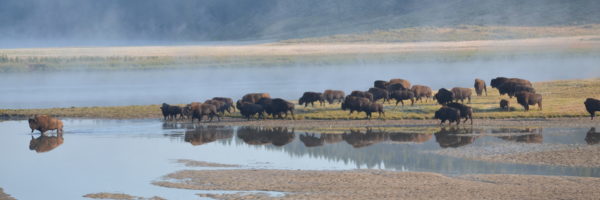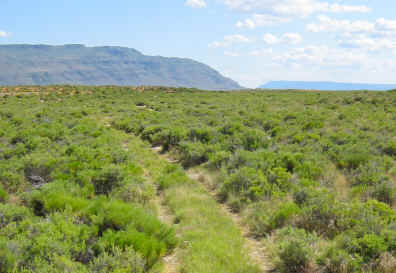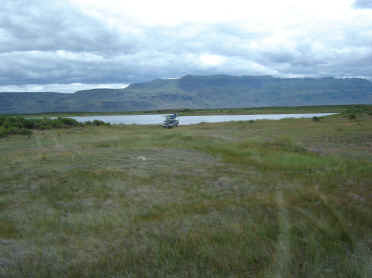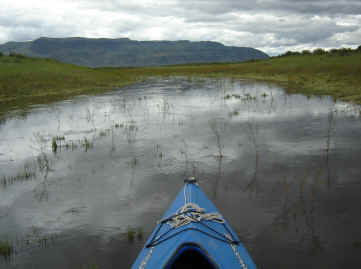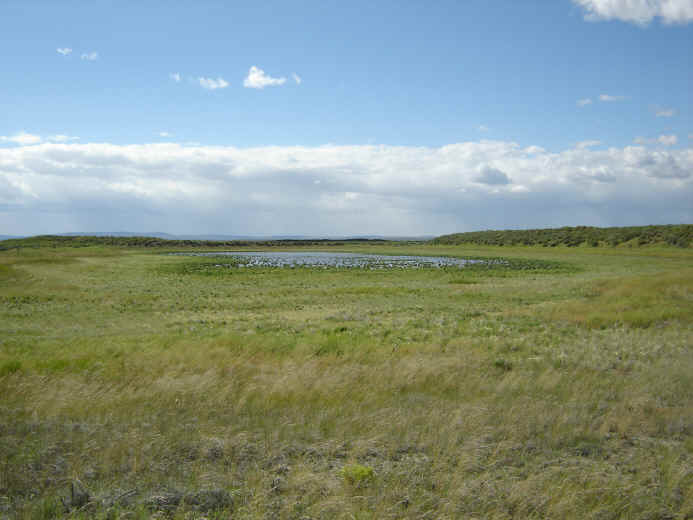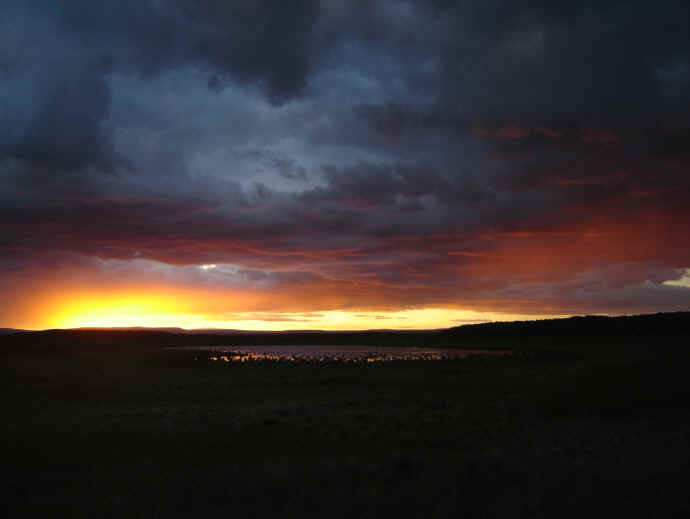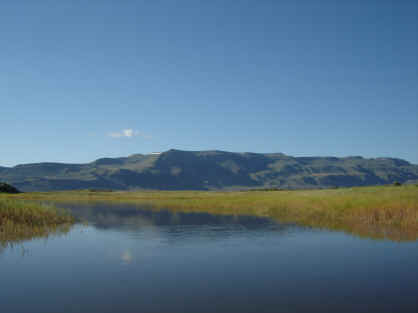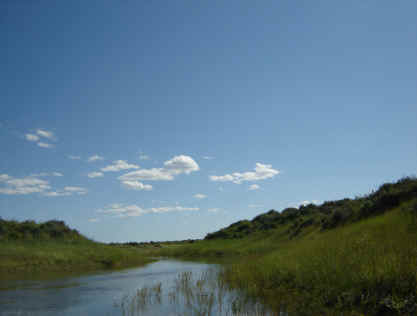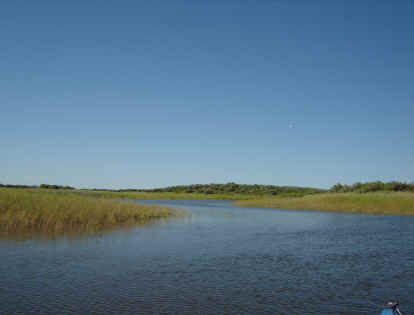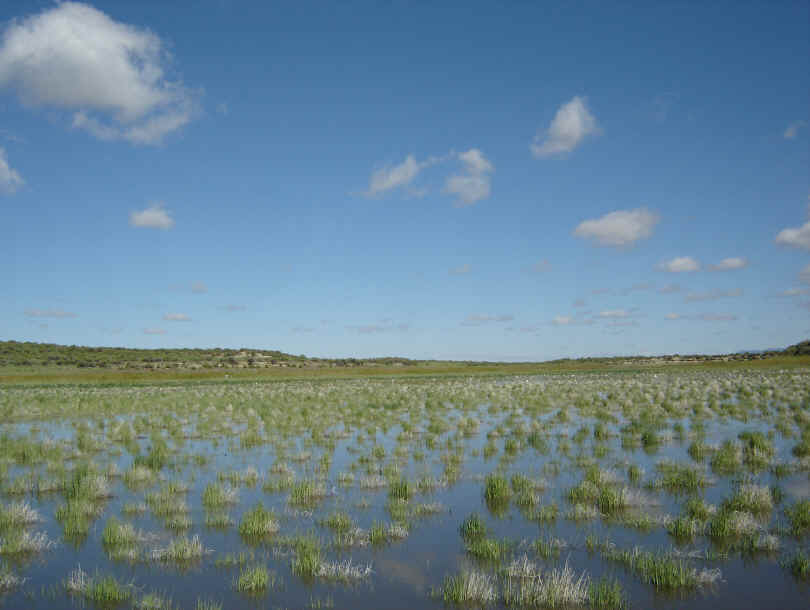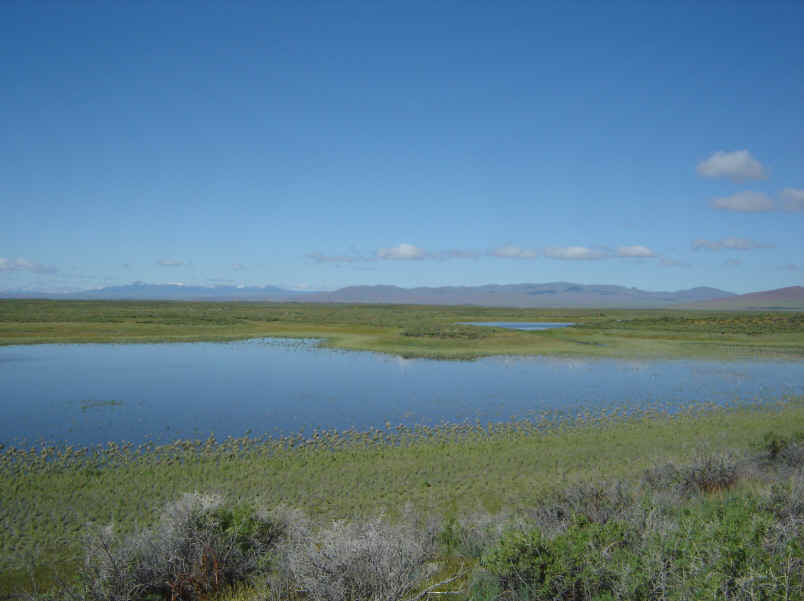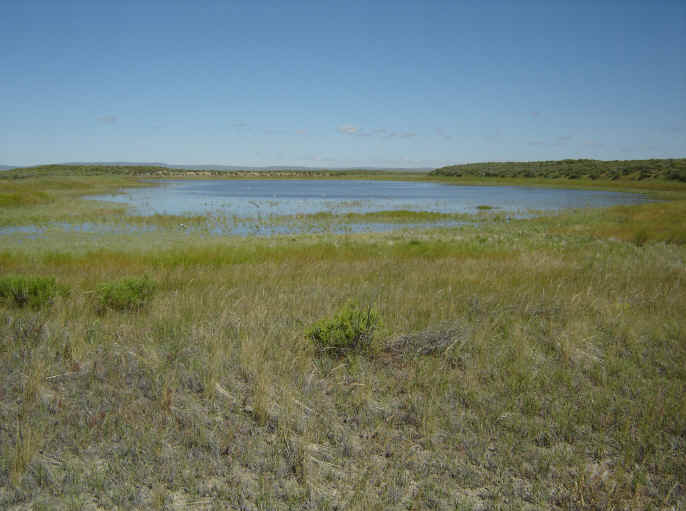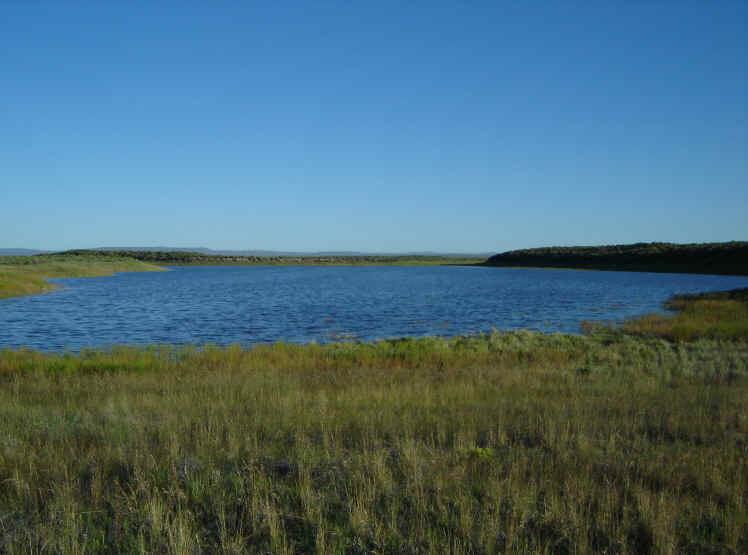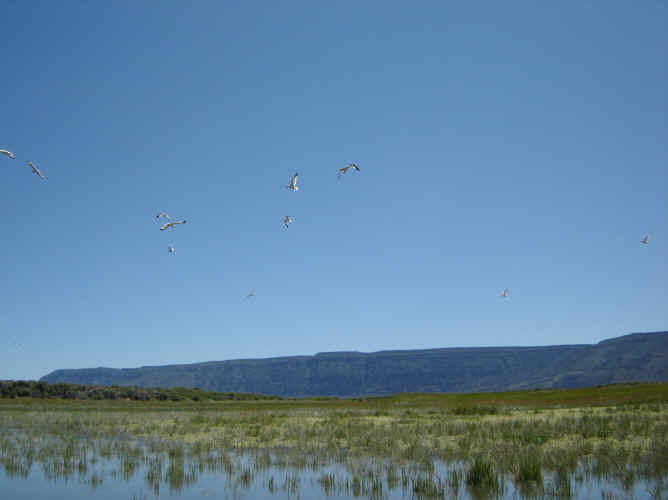
Helping turn the prow of our entropyship, the Earth, back upstream so that Earth’s evolving consciousness may explore the vast headwaters of the Universe for billions of years to come.
Cairns of H.O.P.E. #67 – Beginning of the Long Nights, 2011
Jets and Eddies
Alysia and I have our favorite kayak run on the Sacramento River . There are four places along it where the whole river’s current narrows into a powerful jet. The current then blasts into slower water, shearing it into whirlpools four to five feet wide sucking the surface down 6-8”. The left edge of the current sets the slower water on the left whirling counter-clockwise while the right edge of the current generates whirlpools spinning clockwise on the right. Looking ahead, I guide my paddling so that I cut between these two directions of spin. However, with each whirlpool, some of the forward energy of the current is sucked downward, emerging downstream as upwellings that boil up and flow outwards in all directions from the center of the upwelling. Just as the first whirlpools we come to are the strongest, so the first upwellings are also the strongest, pushing up a couple of inches above the surface level. When the water flowing away from the center of an upwelling shears against the main current that I am trying to follow, smaller whirlpools are set spinning. The smaller whirlpools generate smaller upwellings that set up smaller whirlpools that lead to smaller upwellings. The force of the main current dissipates throughout the slack water via a fractal intertwining of whirling ins and boiling outwards. The same dynamics can be seen throughout but now they are slow and broad, pushing up or pulling down the surface only a fraction of the inch. I’m still trying to follow the line between the counter-clockwise and clockwise rotations but the force of the current has just about expended itself and no longer has the momentum to force its way onward. Instead, the slow uprisings push that dividing line back and forth until the current is gone.
Except, I can still see an ever-shifting line threading between slow counter-clockwise whirls and clockwise whirls. Both those whirls jointly turn the water between them downstream. I can feel the water pull me along if I hit the line right and feel it push me aside if I stray into the whirls. It’s an intriguing area. At the head of the jet, it is definitely the force of the current that drives the whirlpools. But now down here, it is the residue of the rotations that create whatever movement could be called a current. At some point along this gradient of dissipating current, a shift happens within the sequence of cause and effect so that the current causing/creating the whirls becomes the whirls causing/creating the current.
The line between the two whirls gets pushed around so much by the slow upwellings that it is challenging to stay close to it. I look further ahead, trying to detect the earliest sign of the next upwelling. Is there a pattern within this slow motion turbulence that will allow me to anticipate and cleave the pattern smoother?
Chrysalis
Last school year was a hard year. Alysia developed a heart condition that forced her to retire from teaching – much to her frustration. She is still adjusting to retirement and occasional limitations. The other hard thing was a group of parents who wanted Chrysalis to become a school where parents tell teachers how to teach. That was a surprisingly soul-sapping experience. Over the summer, most of those families enrolled elsewhere so we are past that problem. However, I’ve channeled most of my energy into Chrysalis to make sure we have a good year this year.
Alysia, on the other hand, is bringing much of her retired energy to the Occupy Redding movement. So each morning I go to work on our school and each evening I come home to political discussions. The two nourish one another in a complex way that will contribute to this mélange of a Cairns .
The Best
More than twenty years ago, early in my time in Northern California, I went to give a nature presentation at the public school that had a reputation for achieving the highest test scores in the county (and, not coincidentally, having mostly children of doctors, lawyers, and other professionals along with high property values). The school had a front gate, over which a sign still proclaims “Through this gate walk the best students in Shasta County .” I hated that sign. I hate it because it represents one of the many ways in which children born into privilege are taught to think of themselves as better than other people.
Our county has more than twenty-five (mostly small) school districts within twenty miles of each other. Families may apply for inter-district transfers so competition between schools for students is much stronger than the national norm – and the competition for students who score high on test is very high. This competition leads to lots of advertised comparisons and claims about being the best school, usually based on test scores. Chrysalis tries to avoid going down that road. Though our test scores are high (especially considering that we don’t focus on the tests and we do spend part of each school week out in nature (which will never be on a standardized test)), we know that if test scores were the way we measured ourselves, we would surrender that teacher empowerment we treasure. Also, as a charter school, we maintain that because each child is unique, there is no such things as a best school. What our community needs is a diversity of schools so that families have a greater opportunity of finding a school that works for their child.
For both of these reasons, for almost twenty years, my mind almost reflexively swerved away from thinking the word “best” in terms of Chrysalis. But this summer, it suddenly hit me that there was a whole different way of using “best” in education. How do we, as a school, bring out the best within our students? How do we encourage their best? Best – not as a comparison of public externals but as a sorting of inner paths within our students. This meaning has released the word to flow over my tongue many times each day – in a way that feels organizationally powerful.
Last week we received this email from a new Chrysalis family.
“I just wanted to check in with you guys to tell you each how grateful we are to have (child’s name) attend school at Chrysalis. (child’s name) has NEVER come home from school crying about teachers or children being mean to her. She is anxious each day to get up and learn something new. Her brain is ON FIRE for learning about the Oregon Trail and Science on Fridays. She says “Math is fun the way they teach it”. Each one of you has touched my daughter (figuratively of course) in a way that I cannot begin to express gratitude for. I truly believe we were led to Chrysalis for a reason. The other day I was speaking with (child’s name) and asked her how she liked Chrysalis compared to her old school. She remarked “Are you kidding mom, Chrysalis saved my life.” That is pretty much it in a nutshell… Does not get much better than that!
“Even simple things like, saying our last name correctly, mean a lot to us. In the five years she went to the other school, they mispronounced our name the whole time. Despite our correcting them.
“I know people complain about things when there is a reason but also realize that not as many people send an e-mail just to share a positive. This is that e-mail. Thank you again.”
We hear things like this every year, especially with new families. We call them Chrysalis miracles. We are doing some things right.
Bottom Up
Ten years ago or so, I was giving Chrysalis’s annual report to our sponsoring board. I used part of the report to quickly soapbox our opposition to the “all eighth graders will take algebra” movement that was being pushed from on high. (American students are falling behind other nations’ student in science and math as measured by these international tests. Therefore, we will raise our standards so that all students will have taken algebra by eighth grade.) The superintendent politely but firmly shut me down with a “we believe that if taught right, all eighth graders can succeed in algebra”. We, at Chrysalis, never went along with that. Throughout our existence, only a portion of our eighth graders were ready to grasp algebra. They do very well. The rest of our eighth-graders solidify their understanding of pre-algebra and then go on to algebra in high school.
Last month at a meeting of charter schools, this same superintendent was explaining that research was showing that not all eighth graders are developmentally ready for algebra and that it is a mistake requiring them to take it. (The way he phrased these comments contained a coded apology acknowledging I was right many years back.) But back ten years ago, we absolutely knew we were right; we didn’t need some foundation or government-funded published research to know that. We were positive because we were teaching mathematics to eighth-graders.
An important part of Chrysalis’s DNA was inherited from the book, Complexity, by Waldrop. It is most concisely phrased in “Use local control instead of global control. Let the behavior emerge from the bottom up, instead of being specified from the top down. And while you’re at it, focus on ongoing behavior instead of the final result. ” Declaring that all eighth-graders will take algebra is a perfect example of “being specified from the top down.” Similarly, in my mind, the current focus on standardized test scores exemplifies focusing on final results rather than the daily ongoing behavior of students.
In a similar fashion, we are absolutely sure that research will eventually announce that one of the main stumbling blocks to students learning algebra and higher mathematics lies in the way schools currently teach fractions at the third-fifth grades. Far too many students lose their understanding of arithmetic in these grades because fractions are taught far too quickly and superficially. Young students who have learned that multiplication makes numbers bigger are confused by fractions where multiplication makes numbers smaller (and by fraction division that makes numbers larger). In the hope of raising test scores a bit higher, students are led through too many procedures without the time to understand them. If you don’t really understand what 2/3 means, you have little hope of understanding how to add a/b to c/d. We are sure of this fraction-algebra connection because (a) we take the time to teach fractions well and we can see the difference in the upper grades between our long-time students and new students who have transferred in and (b) Alysia teaches our math curriculum to parents (so they can help their children with homework). Most of the mothers experience our fraction curriculum as a revelation and share how they lost it with math somewhere between third and fifth grade.
Somewhat similar, there is a current “push” for more rigorous evaluation of teachers. An article in the New York Times described a new law in Tennessee that would require principals to do 4 observations a year of each teacher at the school. The article went on to say how principals don’t have the time in the day to do this plus everything else they have to do. As the administrator of Chrysalis (some would call me the principal but I am annually evaluated and re-hired by the teachers), I receive much of the correspondence flowing to principals and superintendents. I could easily fill most of my time driving into central offices for meetings with other administrators on how to create a better school. I let most of it flow past because I also teach two classes a day and there is the actual stuff of the day like playing Frisbee with the kids during lunch or working with a student who isn’t getting his homework done or checking in with the other teachers or being available to parents.
Waldrop wrote in Complexity: “Since it’s effectively impossible to cover every conceivable situation, top-down systems are forever running into combinations of events they don’t know how to handle. They tend to be touchy and fragile, and they all too often grind to a halt in a dither of indecision.” I would add another problem to the list. It is far easier to send commands down the hierarchy than to actually execute them. Therefore, log jams can form near the bottom (where the work actually happens) unless the upper echelons of the hierarchy exercise great restraint in their directives and do what’s necessary to develop the trust that will allow them to give to the lower levels of the hierarchy creative autonomy. (Alysia adds: Instead they create orders that are impossible to follow like ‘all children will be proficient at grade level by 2014’. Everyone knows this goal is unachievable. The shear created by being forced to try to do the impossible wastes enormous amounts of creative energy that get spun off into useless whirlpools leading to spiritual dissipation of everyone involved.)
Similarly, I once was talking with a fundraiser about Chrysalis. I was explaining how our small size allowed deeper personal relationships between teachers and families. And the fundraiser said, “You know, the Gates Foundation experimented with small schools and found it didn’t make a difference. Do you think you are smarter than Bill Gates?” I don’t know if I am smarter than Bill Gates or not (I do know he is richer than me and helped create an organization that grew much, much bigger than Chrysalis) but I am closer to the students than he was and I have a different measure of success (“encouraging the light within each student to shine brighter”) than he probably did and I’m not looking for one model of education to scale up to a national solution.
More top-down money is entering the charter school world, looking for educational models that can be scaled up so as to have national impact and/or make money privatizing public education. Schools like Chrysalis are considered “mom and pop” charter schools that have nothing to offer in this search. I believe we do – but it’s not what anyone “up there” is looking for. One thing we have to offer is our mission: encouraging the light within each student to shine brighter. Notice how those nine words follow the dictate of “Use local control instead of global control. Let the behavior emerge from the bottom up, instead of being specified from the top down. And while you’re at it, focus on ongoing behavior instead of the final result.” Public education is being shaped around the measure of standardized test scores – with many consequences we see as damaging to students, teachers, families, nations. “Encouraging the light” is a different measure. At the profoundest levels, Chrysalis and similar schools pose the question of whether we as a nation are even searching for the right thing.
The other thing we have to offer is a teachers’ co-operative model of a school. The top-down, command and control hierarchy of public education can make many things happen. But is it making the right things happen? The teachers at Chrysalis have both academic freedom and the support of one another. It’s a potent combination. The teachers work together a lot. This might be a consequence of our size. The school is not large enough to have two sections of a class being taught by two teachers. Therefore, every teacher will theoretically teach every student. Plus the teachers run the school. My job as administrator is to try to handle all the administrative tasks teachers don’t want to be bothered with while giving them voice to all the decisions that matter. One implication of the teachers running the school is that our collective salaries are dependent on how well the school does. One can’t focus only on one’s own classroom. Each teacher has the opportunity to improve the entire school.
One example of this was the way we hired Alysia’s replacement last year. The leading candidates all came and taught a lesson with the kids who would be in the teacher’s class this year. All the Chrysalis teachers observed – and had the chance to talk with the candidate during the day. But what was nicest was that after Casey was hired, almost all the teachers spent time with him over the summer helping him get ready in a variety of ways. He feels very supported and got off to a strong start from day one of this school year. His strength and confidence benefits everyone.
When I listen to the national dialogue, I hear a distrust of teachers. Teachers need to be observed and evaluated… so they don’t get away with stuff. They need to be ever more firmly set within a hierarchy beneath a higher-paid level of administration that will hold them to the standard. A greater percentage of the resources entering the system is allocated to levels above that of the classroom. Communicating distrust is not the way to inspire the best within someone. One of the joys of Chrysalis is watching the wonderful things that emerge from trusted, creative free teachers helping one another.
Or to put it another way, the direction the national reformers are wanting to take it is in a direction very different from the one we are exploring. I believe the difference lies in the difference in our intents. The “reformers” see the top-down hierarchy as a method they can use to quickly create reform throughout the system therefore they don’t question it or seek to replace it.
Occupy
A similar national conversation is taking place with the Occupy Wall Street movement. Can a “horizontally- organized” movement produce anything? My experience with Chrysalis confirms interesting things can emerge. We live in a very conservative area. However, when I’ve participated in Occupy demonstrations (holding up a Honk 4 Change sign), I’ve been delighted that probably one out of fifteen cars honk, one out of ten of the other cars give a thumbs-up or wave and only one in a hundred gives a thumbs-down type of display of disapproval.
Credit Default Swaps
As I read stories about the Eurozone’s crisis, I hardly ever read about credit default swaps – but the few times I do see mention of them, it seems they play a significant role in the crisis. So what are credit default swaps? The main characteristics I hear of them in articles is that they are a fairly new “instrument”, one of those “derivatives” – whatever they are, and that they are very complex, not easily understood. That doesn’t tell me much.
One day I decided that as a good citizen, I should know more than that so I looked up “credit default swap” on the internet and started reading. I learned enough to make me think our culture needs to have an understanding better than “hard to understand” and since I don’t see many such explanations around me, I will take on the amateur job of presenting some things about credit default swaps that I think need to be more widely understood.
Credit default swaps are contracts between two parties based on whether some organization will default on its debt. The contract is for a certain period of time. One party periodically pays a certain amount of money to the other. In return, the other party becomes legally bound to pay the first party a large amount of money if that organization defaults during that period of time. I’ve heard credit default swaps described as insurance against default and perhaps they originated that way.
For example, a corporation could enter into such contracts. By paying a certain amount of money each year, they have a guarantee that other sources of capital will cover their debt if, by some chance, they had to default. Also like insurance, if the corporation is perceived as increasingly likely to default, then that corporation will have to pay more to entice the other party into entering a contract that will cost that party a great amount of money if the corporation defaults.
However, in many ways, credit default swaps are not like insurance. The biggest difference is that the corporation or nation whose possible default is at the heart of the contract does not have to have any connection with the parties making the contract. Imagine two people making a bet as to whether a train arrives on time. Other than its reputation which presumably influences the odds involved in the bet, the railroad company has absolutely no financial connection to the bet.
Second, credit default swaps have been unregulated. There is no limit on the amount of swaps involved because, as just mentioned, the contracts have no connections with the actual organization that has the debt. Say a corporation has a hundred million dollars of debt. Credit default swaps are not limited to a hundred million dollars of value. The only limit to the amount of swaps is the willingness of two parties to enter into such a contract. No one knows how many swaps exist and to what extent various parties are legally obligated by them. For example, if A and B enter into a CDS contract, B could sell their part of the contract to C (and never notify A) and C could sell it to D who sold it to E and A would never know.
The final key point about credit default swaps is that the vast majority of them are sold “naked”. I can’t quite understand how this works with credit default swaps but I understand this in terms of stocks and options because my dad would do this, causing stress within our family so let me use them as an example. An option is a contract between two parties to sell some stock at a certain price within a certain time frame. Say you have a stock that has a value of one hundred dollars. You might sell for one dollar an option that obligates you to deliver that stock to the person holding the option for one hundred ten dollars anytime in the next half year. If the stock does not reach one hundred ten dollars during that time, the contract expires worthless. You still own the stock plus you made an extra dollar on it. On the other hand, if something were to cause that stock to soar to one hundred and twenty dollars sometime in the next half year, the other party to your option contract would exercise that contract. You would have to sell your stock to them for one hundred ten dollars. You made a ten dollar profit on the sale (instead of twenty) plus you made the extra dollar from selling the option so you came out all right. However, the other party, by buying the contract for one dollar, just purchased a stock worth one hundred twenty dollars for one hundred and ten dollars. If they turn right around and sell the stock, they make nine dollars (ten on the stock minus one for the option contract) on an initial investment of one dollar. That is a 900% gain on investment in half a year. They did very well.
Selling options naked means doing the same thing except you don’t own the stock. You make one dollar each time you sell an option contract for someone to buy the stock from you – but you don’t own the stock. As long as the stock price does not move too much upward, you do fine. You make a dollar with each contract and you haven’t had to tie up any of your money in the actual purchase of a stock. If you sell a thousand of these contracts, you can make a thousand dollars without tying up your own money. It’s a free money machine – as long as the stock does not rise above one hundred ten dollars.
However, if that happens and the other party exercises their option, suddenly, you are required to spend one hundred ten dollars to purchase the stock and then give it free to the person exercising the option you sold. If you had sold one thousand of those options, you must spend one hundred ten thousand dollars to purchase the stock and then give it away. (You might have to spend more than that in a rising market.) You’ve lost one hundred ten thousand dollars (minus whatever you made from selling naked options before this bad turn in the market). That’s what selling “naked” options means.
So credit default swaps can be sold naked. And “Most significantly, unlike insurance companies, sellers of CDSs are not required to maintain any capital reserves to guarantee payment of claims.” (Wikipedia) According to Wikipedia, the vast majority of credit default swaps are sold naked. (A current estimate of the CDS market is 30 trillion dollars, twice the entire GDP of the US . One estimate from the Bank for International Settlements for the entire derivatives market is 592 trillion dollars.) From a short-sighted point of view, selling naked makes sense because it gives you maximum leverage. You get the highest rate of return on the money you have to put up. And rate of return is what it is all about when you are some investment house or hedge fund. A very powerful feedback spiral connects your rate of return and the amount of money invested with you. If you can produce a high rate of return for your clients, you can charge a higher commission and will have a lot more clients.
All of these characteristics of CDS come into play in terms of what is happening in the Eurozone. You get the sense that big banks made naked commitments of trillions of dollars on national debts on the assumption that a “credit event” would never happen and now it is threatening to happen and that no one really knows who would be responsible for paying up and whether they actually have the reserves to pay up. Or, to put it more forcefully, that if a “credit event” occurred and all the legal obligations proceeded as contracted, that the majority of the people whose wealth and power gives them control over vast swathes of the world would be destitute. Destitute in the sense of no clothes on their back. No roof over their head and still with such crushing debts that their descendants for ten generations would be slaves to their debt. In addition, all of the institutions that support their place of power would be bankrupt and no longer exist. Therefore, these people are using all their wealth and power to avoid a “credit event” or deflect it away from them. They have vast power to do this. However, much of their power lies in the ability to enforce contracts so that in order to wiggle out of their contracts, they must undermine the very source of their power. (Part of what strikes me as currently strange is that there is lots of attention focused on forcing governments into austerity cuts and creating billions of dollars to intervene in these markets but little talk about regulating these markets so that governments, the press, and people would actually know how much and whose money is at stake.)
A few weeks ago, it was announced that a deal was going to be worked out whereby banks had agreed to take a 50% “haircut” on Greek debt. But this deal was announced to be “voluntary” and would not be a “credit event” which suddenly made more people aware that a committee from the International Swaps and Derivatives Association determines what constitutes a “credit event”. This association is made up of the major financial firms selling the swaps so there is a growing concern “that credit default swaps are not insurance at all, but rather instruments that big banks use to benefit themselves.” NYTimes, November 19, 2011, Scare Tactics in Greece , Nov. 19, 2011.
If the big banks determine what is a “credit event”, then it becomes even more likely that they would sell trillions of dollars of naked swaps because the committee they control can vote that a default is not a “credit event” and so guarantee there is no down side on these naked sales. Someone once said something like “the way to win the game is to own it.” I have the feeling that what we are seeing is that “Wall Street” (in a more international sense of the phrase), through the creation of credit default swaps and other derivatives, created an alternative, non-governmental currency which, if governments use their assets to bailout, effectively becomes the currency so that “Wall Street” becomes the owner of the printing of money.
One of the main issues of the Occupy movement is economic inequality. Whenever I think about it, I keep coming back to my watershed work. For me, economic inequality is a vital but secondary issue. The more fundamental issue is how should money ideally flow within an economy? I believe it should be recycled often to fall again and again as rain upon the slopes. What we are seeing is a concentration of wealth low in the watershed and how unproductive it is down there. Trillions of dollars in credit default swaps. What kind of truly human aspiration is that serving? Trillions of dollars being leveraged for what? One can argue that more of that money should be shared more widely in the name of economic justice. But I think there is a more politically powerful perspective of economic effectiveness. How pathetically little is being truly created by all the money that has flowed too far downslope. A failure of imagination is draining our culture of economic vitality. It’s not an issue of rich vs. poor but an issue of how possibilities drain away when wealth accumulates downslope. All of us, rich and poor alike, would be uplifted by a flow that recycled and held the wealth of our species higher in the watershed. I believe it is spiritually important to see this as a long-term issue, not of taxing the rich and giving to the poor, but of adjusting thousands of the ongoing flows within an economy so that the money keeps getting recycled back up to flow over and over again.
A half hour after writing the above, I read in Yes! magazine a book review of The Spirit Level: Why Equality is Better for Everyone by Wiklinson and Pickett. A few sentences from the review. “The crux of The Spirit Level is that the best measure of a country’s well-being is not GDP or wealth overall, but its distribution of wealth. Of the developed countries (the focus of the book), those with highest income inequality – the United States, Britain, and Portugal – have the lowest levels of social “goods” such as educational achievement, long life expectancy, gender parity, and trust among neighbors. They have the highest rates of mental illness, obesity, violent crime, teen pregnancy, and incarceration.” “One of the remarkable insights of The Spirit Level is that income inequality affects all social classes, not just the poor. The most unequal countries have rates of mental illness five times higher than the most equitable – for everyone…. The authors emphasize that subtracting the poor from the analysis does not change the score. ‘Inequality,’ they suggest, is ‘like a pollutant spread throughout society.’” “Reducing inequality – not increasing growth – must form the centerpiece of any effort to improve well-being.”
And a few days later after writing that, we learn that a small part of our government secretly lent 7.7 trillion dollars to Wall Street firms without letting Congress know.
As you probably know, I am a big fan of tiny shifts high in the drainage. One little shift we have been enjoying making involves the almost daily receiving of credit card junk mail from the big banks. They include a returned postage guaranteed envelope. We put those envelopes into the mailbox. Junk mail is only profitable if the amount of business it creates is greater than the cost of sending it out. Sending those envelopes back has the power to double the expense of the practice – which could lead to banks stopping the practice – which could prevent some unwary citizen in the future from getting trapped in debt (and save trees).
How did you find this place?
I took one of my former students on his first backpack trip. We hiked cross-country over a pass down into a beautiful meadow. As we hiked back the last day, Bill asked “How did you find that place?” Some surface answer moved towards my tongue but then I paused. There was a good answer I sensed but it was complicated, hard to explain to someone not familiar with the land. As I sorted through possible approaches, one truthful word emerged. “Gradually.” Once that truthful word was spoken, it opened the space so I could take the time to explain how a hike twenty years ago led to another hike that went a bit further that led to another to another until I came upon this meadow which then led to attempts to find an easier route to it. And after all that, the true answer that Bill needed to hear emerged, “By continually exploring my edge.”
